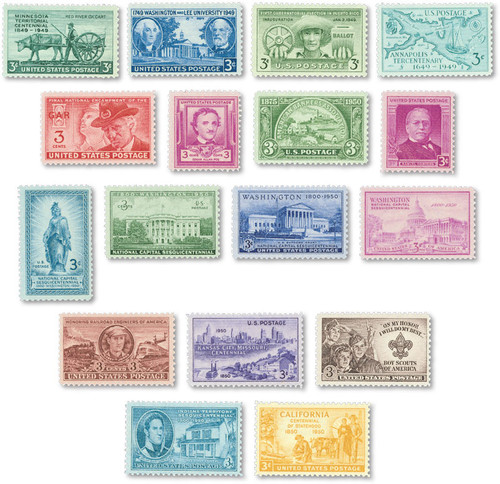
1950 3c California Statehood Centennial
# 997 - 1950 3c California Statehood Centennial
$0.35 - $27.50
U.S. #997
1950 3¢ California Statehood Issue
Centennial
Issue Date: September 9, 1950
City: Sacramento, California
Quantity: 121,120,000
Printed By: Bureau of Engraving and Printing
Printing Method: Rotary Press
Perforations: 11 x 10 ½
Color: Yellow orange
U.S. #997 commemorates the 100th anniversary of California statehood. In 1848, the California territory was ceded to the U.S. in the Mexican-American War. That same year, it experienced a dramatic leap in population after the discovery of gold.The stamp pictures the gold miners who fueled Californias rapid growth, as well as other important resources like oil and citrus fruit.
California Statehood
Mexican forces in California were defeated in the Mexican-American War by the combined tactics of Army Captain John C. Fremont and Commodore Robert Stockton. They had a little help from the locals. A group of 30 American-born settlers seized the small Mexican garrison in Sonoma and took Mexican Commandante Mariano Vallejo prisoner. The settlers drew up their own flag (designed by Abraham Lincoln's brother-in-law) a red bar with a bear. The incident was called the "Bear Flag Revolt" and lasted for about a month until Fremont took control.
Then John Marshall discovered gold at Sutters Mill, near present-day Sacramento.
When word trickled east, there wasn't much reaction at first. But when reports came about how much gold there might be, the rush began. Within three years, California's non-native population jumped from 18,000 to 165,000. The California Territory achieved national importance, and its population was large enough, so it applied for statehood.
U.S. President Zachary Taylor encouraged California's statehood. But the admittance of California would disrupt the balance of slave vs. non-slave states in the Union, and there was bitter opposition from the South. Politicians Henry Clay, John C. Calhoun, and Daniel Webster came up with the Compromise of 1850, which included admitting California as a free state. President Taylor was against the Compromise, but as the legislation was passing through Congress, he suddenly died. His successor, Millard Fillmore, signed the Compromise and California became the 31st state.
U.S. #997
1950 3¢ California Statehood Issue
Centennial
Issue Date: September 9, 1950
City: Sacramento, California
Quantity: 121,120,000
Printed By: Bureau of Engraving and Printing
Printing Method: Rotary Press
Perforations: 11 x 10 ½
Color: Yellow orange
U.S. #997 commemorates the 100th anniversary of California statehood. In 1848, the California territory was ceded to the U.S. in the Mexican-American War. That same year, it experienced a dramatic leap in population after the discovery of gold.The stamp pictures the gold miners who fueled Californias rapid growth, as well as other important resources like oil and citrus fruit.
California Statehood
Mexican forces in California were defeated in the Mexican-American War by the combined tactics of Army Captain John C. Fremont and Commodore Robert Stockton. They had a little help from the locals. A group of 30 American-born settlers seized the small Mexican garrison in Sonoma and took Mexican Commandante Mariano Vallejo prisoner. The settlers drew up their own flag (designed by Abraham Lincoln's brother-in-law) a red bar with a bear. The incident was called the "Bear Flag Revolt" and lasted for about a month until Fremont took control.
Then John Marshall discovered gold at Sutters Mill, near present-day Sacramento.
When word trickled east, there wasn't much reaction at first. But when reports came about how much gold there might be, the rush began. Within three years, California's non-native population jumped from 18,000 to 165,000. The California Territory achieved national importance, and its population was large enough, so it applied for statehood.
U.S. President Zachary Taylor encouraged California's statehood. But the admittance of California would disrupt the balance of slave vs. non-slave states in the Union, and there was bitter opposition from the South. Politicians Henry Clay, John C. Calhoun, and Daniel Webster came up with the Compromise of 1850, which included admitting California as a free state. President Taylor was against the Compromise, but as the legislation was passing through Congress, he suddenly died. His successor, Millard Fillmore, signed the Compromise and California became the 31st state.








